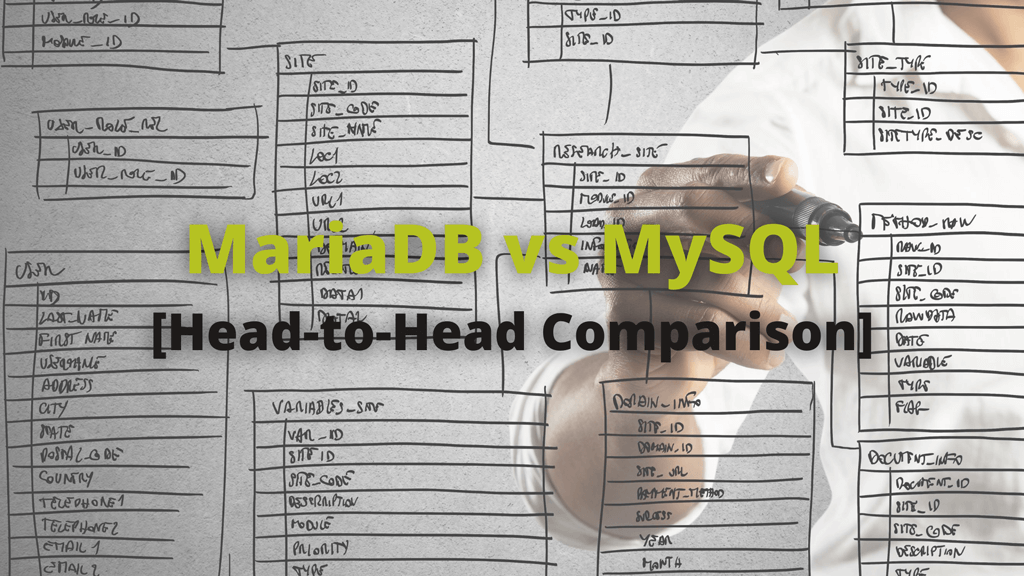
Databases are a method of storing and displaying data that is accessible from the internet. As such, they are an integral part of the proper functioning of millions of websites. The right database choice means you are providing your web project with a fast and safe way to connect to your users.
This is why today, we will make a head-to-head comparison of two of the most popular products on this market — MariaDB and MySQL.
The two database platforms have a lot in common but hold some distinct characteristics as well. Let’s first start with their inception and a look at what they’ve achieved since then.
The following review includes essential information, such as:
What is MySQL?
MySQL is a product of the Swedish company with the same name — MySQL AB — developed way back in 1995. The business later became part of Sun Microsystems, which were acquired by tech giant Oracle in 2010.
By then, the database manager was already rocking the market and, according to a 2020 Statista report, still holds the top stop in popularity, just above Microsoft SQL and PostgreSQL.
MySQL is an open-source project, but Oracle offers a premium solution for enterprise customers as well. The platform utilizes a relational database model to organize data into one or more tables. The administrator can then create, modify, and extract information from the database, as well as determine the permissions and user access.
MySQL is a core part of the LAMP stack (along with Linux, Apache, and PHP), which is the most common server configuration for web hosting providers. It powers some of the most popular content management systems, like WordPress, Joomla, and Drupal.
Dropbox, Netflix, Airbnb, and Twitter are just a few of the many huge enterprises that utilize MySQL for their website needs.
What is MariaDB?
The day Oracle acquired Sun Microsystems, one of the original MySQL developers, Michael Widenius, forked the project and started MariaDB. The new platform was named after Michael’s daughter, and, along with some strong community support, grew to be a great alternative to its predecessor.
MariaDB maintained full compatibility with MySQL, keeping the same APIs, commands, and replacement capabilities. The new product added some new features as well, namely progress reporting and native non-blocking operations.
A couple of years after Widenius started working on the MySQL fork, he had an active part in establishing the MariaDB Foundation that was to oversee the development of the new database management system. Today, the organization is also the biggest provider of support services for MariaDB.
Prominent users of the system include Grooveshark, Accenture, Mozilla, and DBS Bank. The project is also attractive for capital investors, raking in millions in funding from Intel, Alibaba, and the European Investment Bank.
MariaDB vs MySQL — What’s the Difference?
As we are practically talking about the same underlying technology, you can find a lot of similarities between MariaDB vs MySQL. But what are the competitive advantages of each system?
Here is a comprehensive analysis of the main comparable factors.
| MariaDB | MySQL | |
| Architecture | Fully open-source | Open-source + proprietary code |
| Operating Systems | Linux, Windows, MacOS | Linux, Windows, MacOS, Solaris, FreeBSD |
| Storage Containers | 9 | 21 |
| Features | Progress reporting, columnar data store | Data masking, dynamic columns |
| Monitoring | SQLyog | MySQL workbench |
| Routing | MariaDB MaxScale | MySQL router |
| Analytics | MariaDB ColumnStore | No |
| Support | Paid, third-party | Free+Paid enterprise support |
| Price | Free | Free / Enterprise |
As you can see, very few distinctions popup in the MariaDB vs MySQL head-to-head comparison. Let’s dig deeper into the essential elements that can tip the scales in favor of one or the other.
Performance
You can find a lot of different benchmark tests that compare MySQL and MariaDB. While our own tests give a little favor of the latter, there are a lot of variables that can deliver opposite results. Different use cases, queries, and the number of users can usually affect the end scores.
Still, MariaDB often delivers slightly better results because of its superior engine and efficient SQL query optimizer. MySQL offers exclusive tips for database tuning, but those are only available to enterprise Oracle users.
Architecture
MySQL is an open-source system, but since the Oracle acquisition, the platform also has a premium version available for paid users. The project is still going strong for over two decades and gets regular updates, which is a sure sign of active development and eye for innovations.
In comparison, MariaDB remained entirely open-source, and no proprietary code exists for this database type. This means its future depends on a strong community, which actively helps with system improvements, software components, and help with user issues.
Storage Engines
When the system needs to create, read, or update data from your database, it utilizes software modules called storage engines. As you can imagine, you don’t need more than one type of module, so it’s not really a matter of which system supports more, but which has the right one for your project. Still, if we had to count:
MySQL supports exactly 9 transactional and non-transactional storage engines. They are InnoDB, MyISAM, CSV, Memory, Merge, Example, Archive, Blackhole, and Federated.
MariaDB users can also utilize the same storage engines, but they have 12 more to choose from. The new ones are:
- XtraDB
- MariaDB Columnstore
- Aria
- Cassandra Storage Engine
- Connect
- Memory Storage Engine
- Mroonga
- MyRocks
- QQGraph
- Sequence Storage Engine
- FederatedX
- SphinxSE
- Spider
- TokuDB
Operating Systems
Determining the right database type also depends on what Linux distribution you intend on using. MariaDB is becoming the prime choice in an increasing number of operating systems like CentOS, Debian, and Fedora.
While MySQL also supports those OSs, you’d have to change the default settings before creating your database. Other Linux distributions, Ubuntu, for example, still offer the Oracle product as a first option.
Technical Support
All MySQL clients benefit from 24/7 technical assistance from the well-trained Oracle developers. Depending on your needs, you can also opt-in for Premier, Extended, and Sustaining Support. The three packages include professional assistance for maintenance releases, software updates, and bug fixes. Security alerts are also part of MySQL’s offerings.
As MariaDB is a completely open-source product, the community forums are your best bet when you need an issue resolved. You can still find dedicated support for the database system, but only as a paid service. The MariaDB Foundation is by far the best choice when you need assistance with the software.
At Scala Hosting, we support both MariaDB and MySQL as database types. Our managed Cloud VPS solutions come with MySQL access by default, and the unmanaged servers give you the option to install your own OS and choose its database type. You can contact our tech support team 24/7 and find out the best environment for your project.
Final Takes
So, which one is better in the MariaDB vs MySQL comparison?
The two database types use the same underlying open-source technology, so they are similar in many regards — performance, optimizations, syntax. Still, depending on your project, you might get better results with one software or the other.
That’s why it’s always important to know what you’ll be building beforehand, finding the most optimal server configuration is significantly easier after.
FAQ
Q: Is MariaDB the same as MySQL?
A: MariaDB is a fork of the MySQL project, so the two database types are very similar in their structure and syntax. Still, as time goes by, the two are getting increasingly distinct. New MySQL updates are no longer tied with MariaDB, and the latter supports features like native non-blocking operations, not yet introduced for the Oracle database users.
Q: What is MariaDB used for?
A: MariaDB is an open-source software that allows easy data access through an SQL interface. It can provide well-structured data for a wide range of businesses, including banks, realtors, and online shops. MariaDB databases scale great, run fast, and prove incredibly versatile in a variety of use cases.
Q: Does MariaDB replace MySQL?A: MariaDB was not developed as a
MySQL replacement, but more as a viable alternative. Online projects are getting increasingly complex, so software engineers have to get more and more inventive in coming up with suitable solutions. As you don’t have to make any code or configuration changes during transition, MariaDB acts as a drop-in replacement of MySQL.



